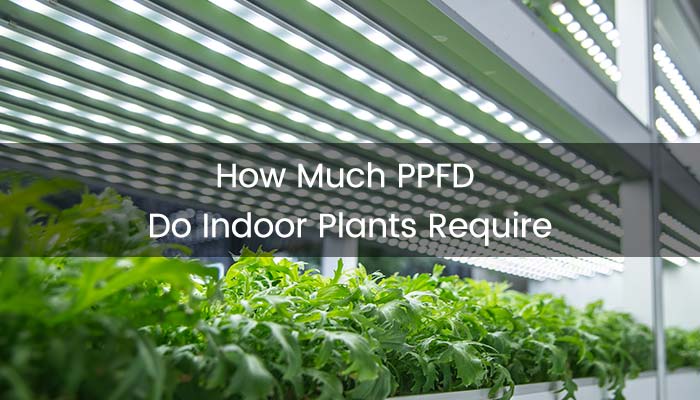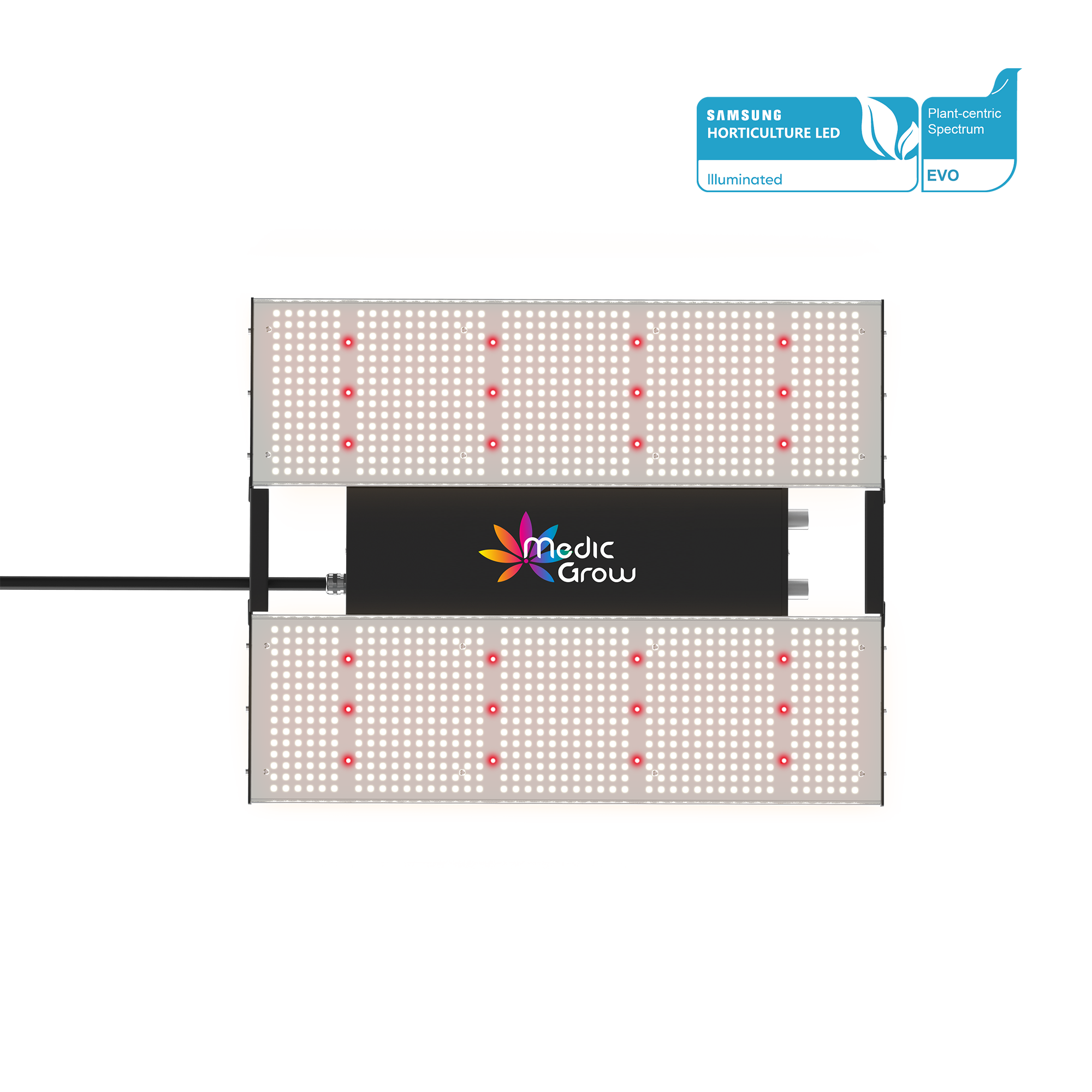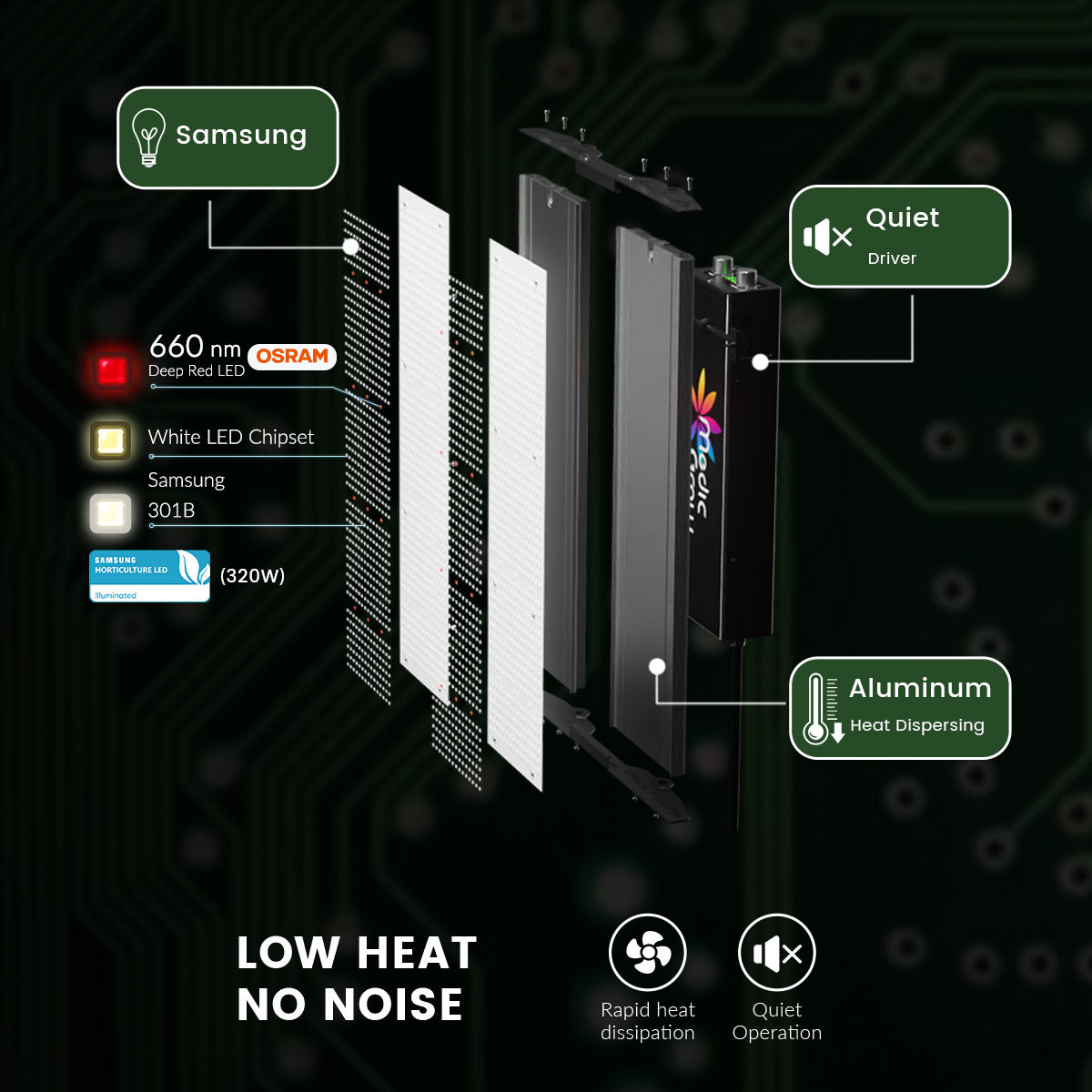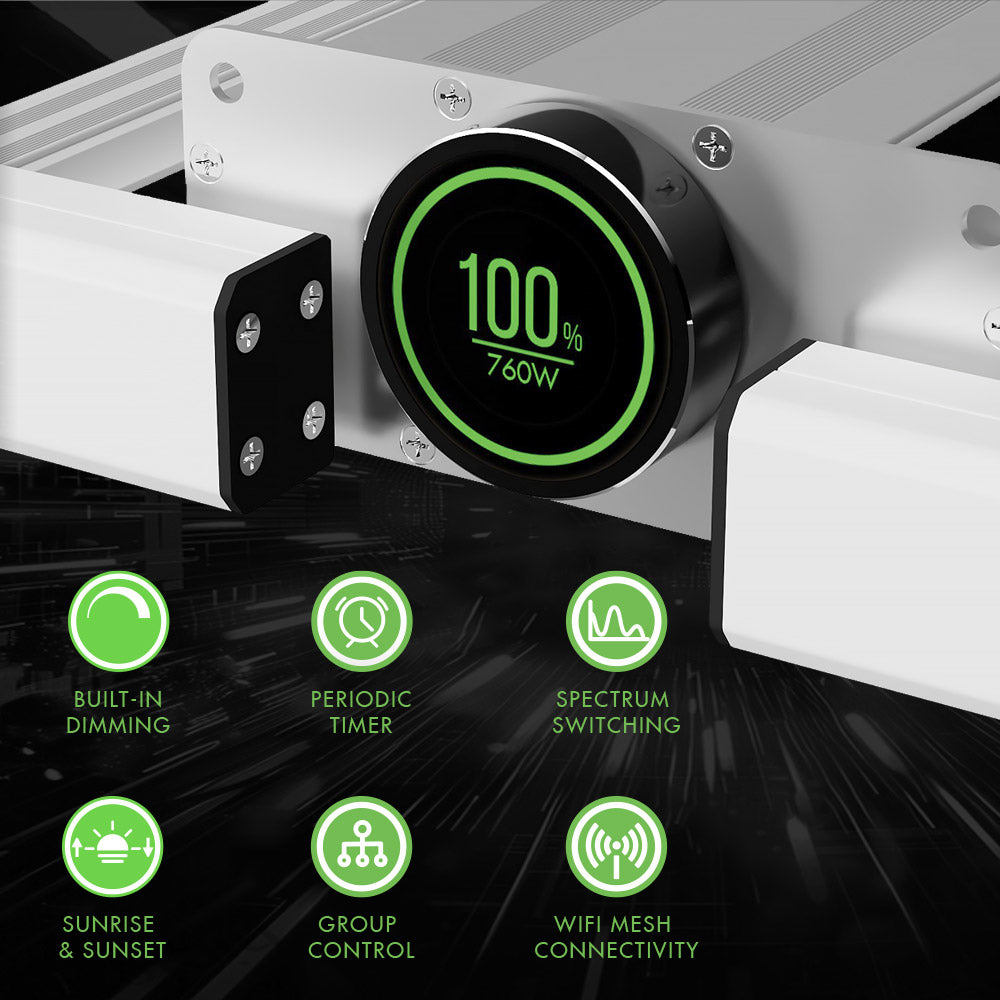
Cây trồng trong nhà cần bao nhiêu PPFD
PPFD cần thiết cho cây trồng trong nhà phụ thuộc vào loại cây và giai đoạn sinh trưởng. Nhìn chung, cây giống hoặc cây nhân bản cần khoảng 100-300 µmol/m²/s, trong khi giai đoạn sinh trưởng cần 400-600 µmol/m²/s. Trong giai đoạn ra hoa, cây cần mức PPFD cao hơn, từ 600-1000 µmol/m²/s.
Với sự phổ biến ngày càng tăng của đèn trồng cây LED , những câu hỏi như " PPFD cho cây giống là bao nhiêu? " và " PPFD cho cây ra hoa là bao nhiêu? " thường nảy sinh. Cường độ ánh sáng phù hợp giúp ngăn ngừa thiệt hại cho cây trồng và thúc đẩy đáng kể sự phát triển.
Trong bài viết này, chúng ta sẽ tìm hiểu PPFD, lý do tại sao nó quan trọng, cách đo lường nó và lượng PPFD mà cây của bạn cần ở các giai đoạn khác nhau để phát triển khỏe mạnh. Tôi hy vọng bạn sẽ đạt được năng suất cao hơn với hướng dẫn của chúng tôi.
Nội dung chính:
- 1. PPFD là gì
- 2. Tại sao PPFD lại quan trọng đối với cây trồng
- 3. Cây trồng của bạn cần bao nhiêu PPFD
- 4. Giá trị PPFD được khuyến nghị cho các giai đoạn tăng trưởng khác nhau
- 5. Cách đo và điều chỉnh PPFD
- 6. Đèn LED trồng cây tốt nhất cho cây trồng trong nhà của bạn
- 7. Kết luận
- 8. Câu hỏi thường gặp liên quan đến PPFD
PPFD là gì
PPFD (Mật độ thông lượng photon quang hợp) đo lượng ánh sáng (400-700nm) thực sự chiếu tới bề mặt của cây. Nó cho biết có bao nhiêu photon có sẵn cho quá trình quang hợp, mà cây sử dụng để chuyển đổi ánh sáng thành năng lượng.
Về bản chất, PPFD cho bạn biết cường độ ánh sáng có thể sử dụng mà cây của bạn nhận được, điều này rất quan trọng đối với sự phát triển của chúng. PPFD càng cao, cây có thể hấp thụ càng nhiều năng lượng, nhưng mức độ phù hợp phụ thuộc vào loại cây và giai đoạn phát triển để tránh tiếp xúc quá nhiều hoặc thiếu ánh sáng.

Tại sao PPFD lại quan trọng đối với cây trồng?
PPFD rất quan trọng đối với cây trồng vì nó tác động trực tiếp đến hiệu quả quang hợp của cây. Quang hợp là nền tảng cho sự phát triển của cây trồng và PPFD đủ thúc đẩy quá trình tổng hợp năng lượng, hỗ trợ tăng trưởng, phát triển và ra hoa. Cường độ ánh sáng phù hợp cũng giúp cây trồng phát triển lá và rễ khỏe mạnh, tăng khả năng phục hồi và năng suất chung.
Điều gì xảy ra khi thiếu ánh sáng
- Tăng trưởng chậm : Thiếu ánh sáng sẽ làm giảm hiệu quả quang hợp, làm chậm quá trình sinh trưởng của cây.
- Lá vàng : Thiếu ánh sáng có thể khiến lá chuyển sang màu vàng, ảnh hưởng tiêu cực đến sức khỏe tổng thể.
- Tăng trưởng chân dài : Để tìm kiếm ánh sáng, cây có thể vươn dài, tạo ra thân cây dài, yếu và không ổn định.
- Ra hoa chậm : Thiếu ánh sáng có thể làm chậm quá trình ra hoa, làm giảm năng suất và chất lượng.
Điều gì xảy ra với ánh sáng quá mức
- Tẩy trắng và cháy nhẹ : PPFD quá cao có thể gây ra hiện tượng tẩy trắng, ảnh hưởng đến quá trình quang hợp và có khả năng dẫn đến cháy lá.
- Tăng bốc hơi nước : Ánh sáng mạnh làm tăng tốc độ bốc hơi nước, làm tăng nhu cầu nước của cây, có thể dẫn đến tình trạng hạn hán.
- Ức chế sự tăng trưởng : Quá nhiều ánh sáng có thể cản trở sự tăng trưởng bình thường ở một số cây, dẫn đến sự phát triển không đồng đều.
- Tăng nguy cơ sâu bệnh : Mức độ ánh sáng cao có thể khiến cây dễ bị sâu bệnh hơn, ảnh hưởng đến sức khỏe tổng thể.
Giá trị PPFD phù hợp có thể ngăn ngừa hiệu quả những vấn đề này và giúp bạn trồng cây khỏe mạnh hơn với năng suất và chất lượng cao hơn. Vậy, cây của bạn cần bao nhiêu PPFD?
Cây của bạn cần bao nhiêu PPFD
PPFD (Mật độ thông lượng photon quang hợp) là một chỉ số quan trọng về cường độ ánh sáng, cho biết lượng ánh sáng mà cây có thể hấp thụ để quang hợp. Lượng PPFD mà cây cần chủ yếu phụ thuộc vào loại cây và giai đoạn sinh trưởng của cây. Dưới đây là các giá trị PPFD được khuyến nghị cho các loại cây phổ biến.
- Cây mọng nước (như xương rồng và lô hội) : Với PPFD khuyến nghị là 200-400 µmol/m²/s, cây mọng nước phát triển tốt dưới ánh sáng mạnh, giúp duy trì màu sắc rực rỡ và giữ cho lá cây khỏe mạnh.
- Cây lá (như pothos, cây lan chi và cây quái vật) : Những cây này phát triển tốt trong môi trường thiếu sáng, với phạm vi PPFD từ 50-150 µmol/m²/s. Ánh sáng quá mức có thể dẫn đến cháy lá, do đó mức ánh sáng thấp hơn là lý tưởng.
- Thực vật có hoa (như hoa lan, hoa clivia và hoa nhài) : Cường độ ánh sáng vừa phải từ 150-250 µmol/m²/s khuyến khích những loại cây này ra hoa mà không gây căng thẳng cho lá hoặc hoa của chúng.
- Các loại thảo mộc và cây thơm (như húng quế, bạc hà và hương thảo) : Với PPFD từ 200-400 µmol/m²/s, ánh sáng mạnh hơn sẽ thúc đẩy cây phát triển nhanh hơn và tăng cường sản xuất tinh dầu và hợp chất thơm.
- Cây dương xỉ (như cây dương xỉ tóc tiên và cây dương xỉ sừng nai) : Cây dương xỉ ưa mức ánh sáng thấp hơn, với PPFD tối ưu là 50-100 µmol/m²/s. Quá nhiều ánh sáng có thể làm hỏng lá mỏng manh của chúng.
- Trái cây và rau quả (như cà chua và ớt) : Những loại cây này cần mức độ ánh sáng cao hơn, đặc biệt là trong thời kỳ ra hoa và kết trái, với PPFD là 400-600 µmol/m²/s để đảm bảo cây sinh trưởng mạnh và cho năng suất tối ưu.
Ngoài ra, một số loại cây có nhu cầu PPFD khác nhau đáng kể ở các giai đoạn sinh trưởng khác nhau, đòi hỏi phải theo dõi và điều chỉnh thường xuyên mức PPFD để đảm bảo cây phát triển tối ưu.

Giá trị PPFD được khuyến nghị cho các giai đoạn tăng trưởng khác nhau
Yêu cầu về PPFD (Mật độ thông lượng photon quang hợp) thay đổi tùy theo từng giai đoạn sinh trưởng của cây, vì mỗi giai đoạn có mục tiêu riêng biệt cho quá trình sinh trưởng và quang hợp. Dưới đây là các giá trị PPFD được khuyến nghị cho từng giai đoạn:
PPFD tối ưu cho giai đoạn cây con
Ở giai đoạn cây con, cây tập trung vào sự phát triển ban đầu của lá và rễ. Mức PPFD thấp hơn 100-300 µmol/m²/s ngăn không cho lá non mỏng manh bị cháy.
Trong giai đoạn này, ánh sáng xanh (450-495nm) rất quan trọng và có thể tăng cường sản xuất diệp lục, hỗ trợ cây phát triển hệ thống rễ khỏe mạnh và cấu trúc nhỏ gọn.
PPFD tối ưu cho giai đoạn sinh trưởng
Trong giai đoạn sinh trưởng, cây cần nhiều ánh sáng trong khoảng 400-600 µmol/m²/s để tạo điều kiện cho thân cây cứng cáp, lá phát triển mạnh và quang hợp. Mức cường độ ánh sáng này cũng thúc đẩy quá trình sinh trưởng, chuẩn bị cho cây vào giai đoạn ra hoa năng suất.
Đối với quang phổ, giai đoạn này chủ yếu cần ánh sáng xanh và một ít ánh sáng đỏ, giúp kích thích thân và lá phát triển khỏe mạnh, duy trì cấu trúc khỏe mạnh, nhỏ gọn và cải thiện sức sống tổng thể của cây.
PPFD tối ưu cho giai đoạn ra hoa
Trong giai đoạn ra hoa, cây cần mức PPFD cao hơn là 600-900 µmol/m²/s. Cường độ ánh sáng này thúc đẩy quá trình quang hợp, tăng cường sự phát triển của hoa và năng suất chung. Ánh sáng đầy đủ cũng thúc đẩy quá trình tổng hợp đường và hormone cần thiết cho sự hình thành nụ mạnh mẽ.
Ánh sáng đỏ rất quan trọng ở giai đoạn này vì nó thúc đẩy quá trình ra hoa, tăng số lượng và chất lượng hoa. Một lượng nhỏ ánh sáng xanh giúp duy trì lá khỏe mạnh và ngăn ngừa tình trạng lá bị kéo căng quá mức.
Giai đoạn ngủ đông hoặc chuyển tiếp
Trong giai đoạn ngủ đông hoặc chuyển tiếp, cây cần ít ánh sáng hơn đáng kể (50-100 µmol/m²/s). Ánh sáng nhẹ nhàng hỗ trợ quang hợp tối thiểu, tiết kiệm năng lượng và chuẩn bị cho cây cho chu kỳ tăng trưởng tiếp theo mà không bị kích thích quá mức.
Các giá trị PPFD được khuyến nghị và sự kết hợp quang phổ ánh sáng này được thiết kế để đáp ứng nhu cầu cụ thể của cây trồng ở từng giai đoạn sinh trưởng, cho phép cây tận dụng tối ưu ánh sáng để phát triển khỏe mạnh.

Cách đo và điều chỉnh PPFD
Để đo và điều chỉnh PPFD (Mật độ thông lượng photon quang hợp) hiệu quả, bạn sẽ cần một bộ điều khiển đèn trồng cây chuyên dụng và máy đo PPFD được thiết kế để đo cường độ ánh sáng trong phạm vi 400-700 nm.
Bắt đầu bằng cách chọn một máy đo chất lượng đã được hiệu chuẩn đúng theo hướng dẫn của nhà sản xuất.
Trước khi thực hiện bất kỳ phép đo nào, hãy đảm bảo an toàn bằng cách đeo kính bảo hộ và mặc quần áo phù hợp, vì đèn trồng cây có thể cực kỳ sáng, đôi khi mạnh như ánh sáng mặt trời.
Để biết thêm thông tin chi tiết về những rủi ro tiềm ẩn của đèn trồng cây, bạn cũng có thể tham khảo bài viết Đèn trồng cây có gây hại cho con người không .
Khi bạn đã sẵn sàng đo, hãy đặt cảm biến ở độ cao của tán cây nơi ánh sáng sẽ chiếu tới cây của bạn. Đảm bảo cảm biến nằm ngang và hướng lên trên để có được số đọc chính xác.
Bật đồng hồ đo và đo tại nhiều điểm khác nhau trong không gian trồng trọt của bạn. Điều này sẽ giúp bạn hiểu toàn diện về cách ánh sáng phân bổ trên cây của bạn.
So sánh các số đọc với các giá trị PPFD được khuyến nghị cho loại cây và giai đoạn phát triển cụ thể của bạn. Nếu cần, hãy điều chỉnh thiết lập ánh sáng của bạn bằng bộ dụng cụ lều nông nghiệp để đảm bảo tiếp xúc ánh sáng tối ưu.
Đo và điều chỉnh PPFD thường xuyên cho phép bạn duy trì cường độ ánh sáng lý tưởng cho cây trồng, thúc đẩy cây phát triển khỏe mạnh và mạnh mẽ hơn.
Đèn LED trồng cây tốt nhất cho cây trồng trong nhà của bạn
Sau khi đọc thông tin trên, bạn có thể nghĩ rằng trồng cây trong nhà rất phức tạp nhưng đừng lo lắng. Medic Grow NEO-780 được thiết kế để cung cấp quang phổ và cường độ ánh sáng tối ưu cho các giai đoạn phát triển khác nhau.
Ngoài ra, sản phẩm còn có hệ thống điều khiển tích hợp cho phép bạn dễ dàng điều chỉnh cường độ ánh sáng, thời lượng và quang phổ, giúp quá trình trồng cây của bạn diễn ra suôn sẻ và không gặp rắc rối.
Bạn muốn tìm hiểu thêm và tăng năng suất? Hãy ghé thăm Đèn trồng cây LED Medic Grow ngay hôm nay!
Phần kết luận
Mỗi loại cây và giai đoạn sinh trưởng có nhu cầu ánh sáng riêng, vì vậy điều quan trọng là phải điều chỉnh cường độ ánh sáng cho phù hợp. Bằng cách cung cấp lượng ánh sáng phù hợp, bạn có thể giúp cây phát triển mạnh, cho dù đó là cây mọng nước, cây lá hay giống cây có hoa.
Bài viết liên quan:
Nhiệt độ và độ ẩm tối ưu cho lều trồng cây
Đèn trồng cây có hiệu quả không?
Đèn LED trồng cây tốt nhất năm 2024
Câu hỏi thường gặp liên quan đến PPFD
1. Cây có thể nhận quá nhiều ánh sáng LED không?
Có, cây có thể nhận được quá nhiều ánh sáng LED, dẫn đến căng thẳng hoặc hư hại do ánh sáng. Tiếp xúc quá nhiều với ánh sáng cường độ cao có thể dẫn đến cháy lá, bạc màu và còi cọc, dẫn đến năng suất và ra hoa kém.
2. PPFD lý tưởng cho cây ra hoa muộn là bao nhiêu?
Ở giai đoạn ra hoa muộn, cây thường cần PPFD cao hơn từ 800-1000 µmol/m²/s để hỗ trợ sự phát triển của hoa và quả. Ở giai đoạn này, cây tập trung vào việc tạo ra các nụ hoặc quả dày đặc, do đó cường độ ánh sáng cao hơn giúp tối đa hóa quá trình quang hợp và sản xuất năng lượng.
Sản phẩm nổi bật
Bài đăng trên blog
Hãy liên hệ với chúng tôi nếu bạn có bất kỳ ý tưởng nào!
- Chọn một lựa chọn dẫn đến làm mới toàn bộ trang.
!
































